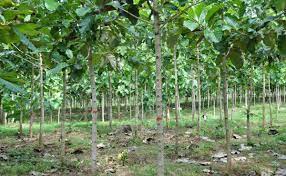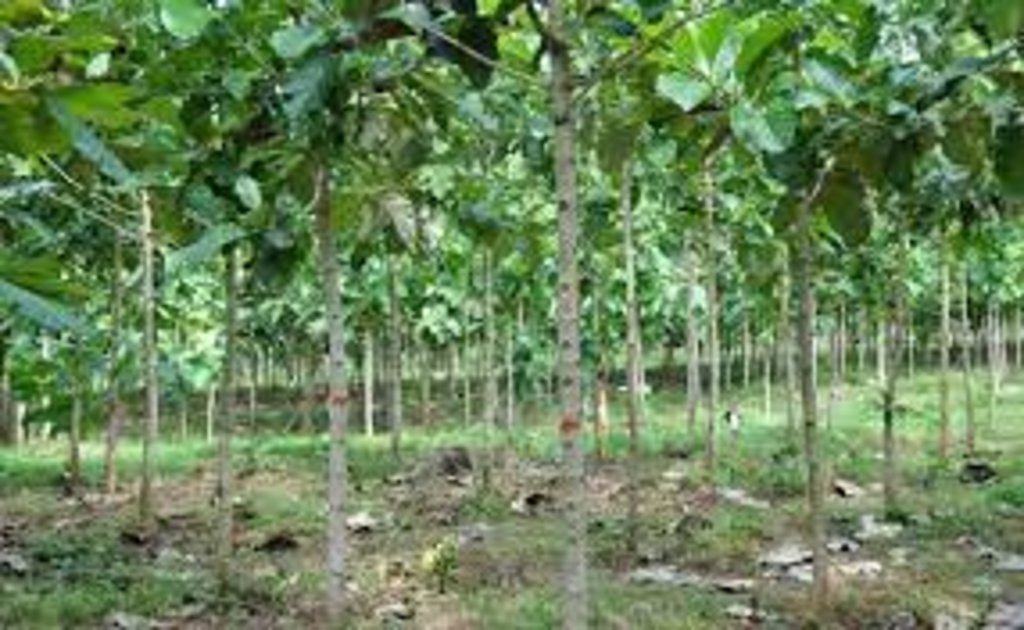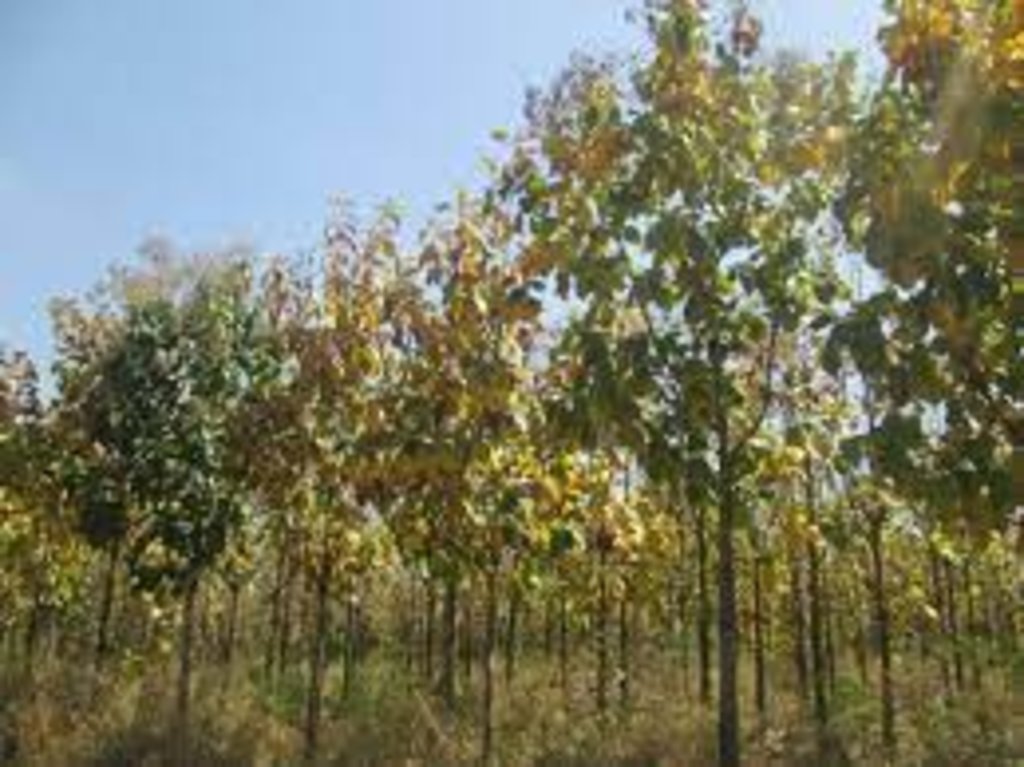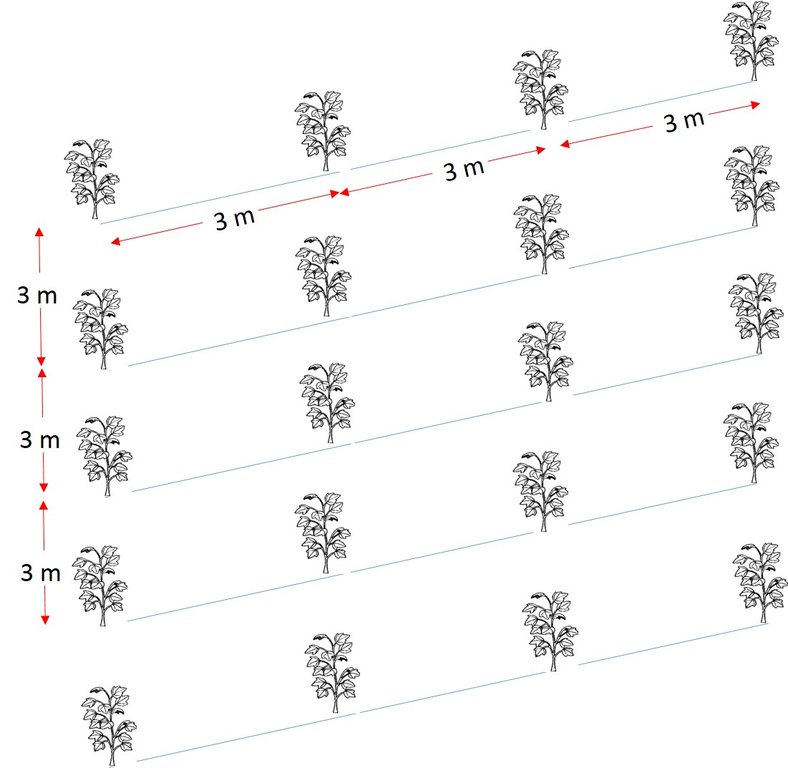TEAK-BASED AFFORESTATION FOR INCOME GENERATION AND TIMBER PRODUCTION [乌干达]
- 创建:
- 更新:
- 编制者: betty adoch
- 编辑者: JOY TUKAHIRWA, Kamugisha Rick Nelson
- 审查者: Udo Höggel
pito yen
technologies_2708 - 乌干达
查看章节
全部展开 全部收起1. 一般信息
1.2 参与该技术评估和文件编制的资源人员和机构的联系方式
关键资源人
土地使用者:
Okot Parkston
0782406820
Lamwo district local government
Padibe west Sub county, Ywaya parish
乌干达
有助于对技术进行记录/评估的项目名称(如相关)
Scaling-up SLM practices by smallholder farmers (IFAD)有助于对技术进行记录/评估的机构名称(如相关)
CDE Centre for Development and Environment (CDE Centre for Development and Environment) - 瑞士1.3 关于使用通过WOCAT记录的数据的条件
(现场)数据是什么时候汇编的?:
12/05/2017
编制者和关键资源人员接受有关使用通过WOCAT记录数据的条件。:
是
1.4 所述技术的可持续性声明
这里所描述的技术在土地退化方面是否存在问题,导致无法被认为是一种可持续的土地管理技术?:
否
2. SLM技术的说明
2.1 技术简介
技术定义:
Teak commonly refered to as Tectona grandis is preferred as a timber species in Northern Uganda by both small, medium and large scale farmers. A teak plantation is normally established for purposes of providing timber and income but also sequester atmospheric carbon dioxide and act as wind break.
2.2 技术的详细说明
说明:
To establish this practice, the land-user puts into consideration the following: pitting at a depth of 3.5 inch, trees to be planted and spaced at 3 metres x 3 meters using the following inputs: tree seedlings, wheelbarrow, hoes, pangas and labour.
During the process, the tree stems are cut at 30cm length and planted. The stem is placed upright and later covered with soil. If there is adequate rain then some tip of the stem is left exposed but if rainfall is inadequate then the stem tip is covered in order for the plant to have enough moisture for its growth. It takes two weeks for the tip to get exposed on the surface when fully covered. The plant automatically appears with two leave lets.
The leaves when exposed to excessive sunlight can dry up and this retards its growth. This may require watering by the land user. At the early stage, the teak plantation can be inter cropped with beans and other crops such as sesame since the teak plantation has not yet formed a big canopy. This can be done for two years and later only slashing within the plantation needs to be done to maintain the plantation. The dry fallen leaves also kill weeds hence easing maintenance work. The trees are to be protected from fire outbreaks during dry season. In the month of November, fire lines are to be created and the dry leaves collected to mulch the plantation.
The cost of establishing a Teak plantations is high in the first 2-3 years but reduces significantly after first thinning. The cost of weeding can be reduced by spot-weeding of seedlings up to age 3 years, after which slashing or spraying with herbicides, usually Round-up is used for weed control. Wood from thinning is also sold as firewood or construction poles to recover some the establishment costs.
Shedding of teak leaves is heavy during the dry season and this causes a risk of fire. It’s advisable at this stage that the land user puts in place fire lines, an open space of 6 meters to separate the plantation into compartments in order to restrict fire from spreading from one part to another part.
Teak plantations are good at responding to dry conditions and can provide high-quality timber which in turn provides income. Teak trees provide hardwood timber, poles and modify the micro-climate through evapotranspiration. Fencing is done using bulb wires to avoid damage by wild animals and encroachments. The teak trees occupy land for a long period of time that can be used for other purposes like planting food crops. The piled dry teak leaves may harbour dangerous animals like snakes. Community members also complain about too much rainfall brought about by the plantation.
2.3 技术照片
2.5 已应用该技术的、本评估所涵盖的国家/地区/地点
国家:
乌干达
区域/州/省:
Northern Uganda
2.6 实施日期
注明实施年份:
2009
2.7 技术介绍
详细说明该技术是如何引入的:
- 通过土地使用者的创新
注释(项目类型等):
The land user copied the technique of teak planting from his friend in Arua District.
3. SLM技术的分类
3.1 该技术的主要目的
- 改良生产
- 减少、预防、恢复土地退化
- 降低灾害风险
- 适应气候变化/极端天气及其影响
- 减缓气候变化及其影响
- 创造有益的经济影响
3.2 应用该技术的当前土地利用类型

农田
- 多年一作(非木材)
主要农作物(经济作物及粮食作物):
Beans and sim sim

森林/林地
植树造林:
- 单一栽培的外来品种
产品和服务:
- 木材
- 薪材
- 其它森林产品
- 自然保持/保护
如果由于技术的实施而导致土地用途发生变化,则在技术实施前说明土地利的用途。:
Crop land garden for sesame growing.
3.3 有关土地利用的更多信息
该技术所应用土地的供水:
- 雨养
注释:
improved variety drought resistant and fast maturing
每年的生长季节数:
- 1
3.4 该技术所属的SLM组
- 森林种植管理
3.5 技术传播
具体说明该技术的分布:
- 均匀地分布在一个区域
如果该技术均匀地分布在一个区域上,请注明覆盖的大致区域。:
- < 0.1 平方千米(10 公顷)
3.6 包含该技术的可持续土地管理措施

植物措施
- V1:乔木和灌木覆盖层

结构措施
- S11:其它
注释:
Firelines to prevent fire out breaks during the dry season.
3.7 该技术强调的主要土地退化类型

土壤水蚀
- Wt:表土流失/地表侵蚀
- Wg:冲沟侵蚀/沟蚀

土壤风蚀
- Et:表土流失
- Ed:风蚀风积
3.8 防止、减少或恢复土地退化
具体数量名该技术与土地退化有关的目标:
- 防止土地退化
- 减少土地退化
4. 技术规范、实施活动、投入和成本
4.1 该技术的技术图纸
4.2 技术规范/技术图纸说明
Teak is planted on a gently sloping natural environment with pitting done at a depth of 3.5 inch Trees are spaced at 3 metres x 3 meters using the following in puts: tree seedlings, wheel barrow hoe, pangas and labour.
4.3 有关投入和成本计算的一般信息
具体说明成本和投入是如何计算的:
- 每个技术区域
注明尺寸和面积单位:
6acres
其它/国家货币(具体说明):
UGX
注明雇用劳工的每日平均工资成本:
5000shs
4.4 技术建立活动
| 活动 | 措施类型 | 时间 | |
|---|---|---|---|
| 1. | Site clearing for nursery bed | 植物性的 | dry and wet |
| 2. | Ploughing | 植物性的 | wet season |
| 3. | Pitting | 植物性的 | wet season |
| 4. | Planting | 植物性的 | wet season |
注释:
Constant weeding and slashing is needed.
4.5 技术建立所需要的费用和投入
| 对投入进行具体说明 | 单位 | 数量 | 单位成本 | 每项投入的总成本 | 土地使用者承担的成本% | |
|---|---|---|---|---|---|---|
| 劳动力 | Hired labours | Manday | 30.0 | 3000.0 | 90000.0 | 100.0 |
| 设备 | Ox-plough | pieces | 1.0 | 280000.0 | 280000.0 | 100.0 |
| 设备 | Pangas | pieces | 15.0 | 10000.0 | 150000.0 | 100.0 |
| 设备 | Axes | pieces | 7.0 | 15000.0 | 105000.0 | 100.0 |
| 设备 | String for lining | bundle | 2.0 | 10000.0 | 20000.0 | 100.0 |
| 植物材料 | Teak-seedlings | Stem | 6000.0 | 1000.0 | 6000000.0 | 100.0 |
| 技术建立所需总成本 | 6645000.0 | |||||
4.6 维护/经常性活动
| 活动 | 措施类型 | 时间/频率 | |
|---|---|---|---|
| 1. | Hiring plantation manager | 管理 | dry and wet |
| 2. | Weeding for 2years after planting | 管理 | wet season |
| 3. | Slashing only after 2years | 管理 | dry and wet |
| 4. | Prunning | 管理 | wet season |
| 5. | Thining | 管理 | wet season |
| 6. | Fenching the plantation | 管理 | dry and wet |
| 7. | Creating firelines during dry seasons | 管理 | dry season |
| 8. | spraying | 管理 | wet and dry season |
4.7 维护/经常性活动所需要的费用和投入(每年)
| 对投入进行具体说明 | 单位 | 数量 | 单位成本 | 每项投入的总成本 | 土地使用者承担的成本% | |
|---|---|---|---|---|---|---|
| 劳动力 | Plantation watchman | acres | 2.0 | 150000.0 | 300000.0 | 100.0 |
| 劳动力 | Labour for fenching | acres | 8.0 | 100000.0 | 800000.0 | 100.0 |
| 设备 | Poles for fenching | acres | 790.0 | 2000.0 | 1580000.0 | 100.0 |
| 设备 | Bulb wires | bundle | 4.0 | 150000.0 | 600000.0 | 100.0 |
| 设备 | Fellkin (for termites) | bottles | 5.0 | 7000.0 | 35000.0 | 100.0 |
| 技术维护所需总成本 | 3315000.0 | |||||
5. 自然和人文环境
5.1 气候
年降雨量
- < 250毫米
- 251-500毫米
- 501-750毫米
- 751-1,000毫米
- 1,001-1,500毫米
- 1,501-2,000毫米
- 2,001-3,000毫米
- 3,001-4,000毫米
- > 4,000毫米
指定年平均降雨量(若已知),单位为mm:
850.00
有关降雨的规范/注释:
Moderate rains during wet season
注明所考虑的参考气象站名称:
Kitgum weather station
农业气候带
- 半湿润
Savanna climate
5.2 地形
平均坡度:
- 水平(0-2%)
- 缓降(3-5%)
- 平缓(6-10%)
- 滚坡(11-15%)
- 崎岖(16-30%)
- 陡峭(31-60%)
- 非常陡峭(>60%)
地形:
- 高原/平原
- 山脊
- 山坡
- 山地斜坡
- 麓坡
- 谷底
垂直分布带:
- 0-100 m a.s.l.
- 101-500 m a.s.l.
- 501-1,000 m a.s.l.
- 1,001-1,500 m a.s.l.
- 1,501-2,000 m a.s.l.
- 2,001-2,500 m a.s.l.
- 2,501-3,000 m a.s.l.
- 3,001-4,000 m a.s.l.
- > 4,000 m a.s.l.
说明该技术是否专门应用于:
- 不相关
关于地形的注释和进一步规范:
Flat landscape supports mechanisation
5.3 土壤
平均土层深度:
- 非常浅(0-20厘米)
- 浅(21-50厘米)
- 中等深度(51-80厘米)
- 深(81-120厘米)
- 非常深(> 120厘米)
土壤质地(表土):
- 中粒(壤土、粉土)
土壤质地(地表以下> 20厘米):
- 粗粒/轻(砂质)
表土有机质:
- 中(1-3%)
5.4 水资源可用性和质量
地下水位表:
5-50米
地表水的可用性:
好
水质(未处理):
良好饮用水
水的盐度有问题吗?:
否
该区域正在发生洪水吗?:
否
关于水质和水量的注释和进一步规范:
The community uses borehole water which is suitable for consumption.
5.5 生物多样性
物种多样性:
- 高
栖息地多样性:
- 高
关于生物多样性的注释和进一步规范:
Variety of wild species exists
5.6 应用该技术的土地使用者的特征
定栖或游牧:
- 定栖的
生产系统的市场定位:
- 混合(生计/商业
非农收入:
- 收入的10-50%
相对财富水平:
- 平均水平
个人或集体:
- 个人/家庭
机械化水平:
- 手工作业
- 畜力牵引
性别:
- 女人
- 男人
土地使用者的年龄:
- 青年人
- 中年人
5.7 应用该技术的土地使用者拥有或租用的平均土地面积
- < 0.5 公顷
- 0.5-1 公顷
- 1-2 公顷
- 2-5公顷
- 5-15公顷
- 15-50公顷
- 50-100公顷
- 100-500公顷
- 500-1,000公顷
- 1,000-10,000公顷
- > 10,000公顷
这被认为是小规模、中规模还是大规模的(参照当地实际情况)?:
- 中等规模的
注释:
More land can be used for teak growing.
5.8 土地所有权、土地使用权和水使用权
土地所有权:
- 个人,未命名
土地使用权:
- 个人
用水权:
- 社区(有组织)
注释:
Land user has to acquire land title for security purposes.
5.9 进入服务和基础设施的通道
健康:
- 贫瘠
- 适度的
- 好
教育:
- 贫瘠
- 适度的
- 好
技术援助:
- 贫瘠
- 适度的
- 好
就业(例如非农):
- 贫瘠
- 适度的
- 好
市场:
- 贫瘠
- 适度的
- 好
能源:
- 贫瘠
- 适度的
- 好
道路和交通:
- 贫瘠
- 适度的
- 好
饮用水和卫生设施:
- 贫瘠
- 适度的
- 好
金融服务:
- 贫瘠
- 适度的
- 好
6. 影响和结论性说明
6.1 该技术的现场影响
社会经济效应
生产
木材生产
SLM之前的数量:
low
SLM之后的数量:
high
注释/具体说明:
Fuel wood obtained from teak pruned branches
森林/林地质量
SLM之前的数量:
low
SLM之后的数量:
high
注释/具体说明:
Shrub vegetation maintained with no cultivation taking place at the technology site
产品多样性
SLM之前的数量:
Low
SLM之后的数量:
High
注释/具体说明:
Hard wood timber provided for construction purposes
能源生产
SLM之前的数量:
low
SLM之后的数量:
high
注释/具体说明:
Woodfuel provided from the pruned branches
收入和成本
农业收入
SLM之前的数量:
low
SLM之后的数量:
high
注释/具体说明:
From the sale of branches, poles and timbers sold to generate income
收入来源的多样性
SLM之前的数量:
low
SLM之后的数量:
high
注释/具体说明:
Income from poles and timber production other than only crop
工作量
SLM之前的数量:
high
SLM之后的数量:
low
注释/具体说明:
Teak forests are easy to maintain since the dense canopy kills weed underneath
社会文化影响
SLM/土地退化知识
SLM之前的数量:
low
SLM之后的数量:
high
注释/具体说明:
trees conserve soil and biodiversity
生态影响
土壤
土壤水分
SLM之前的数量:
low
SLM之后的数量:
high
注释/具体说明:
High water retention in the soil
土壤覆盖层
SLM之前的数量:
low
SLM之后的数量:
high
土壤流失
SLM之前的数量:
High
SLM之后的数量:
low
注释/具体说明:
Forest cover reduces the loss by binding the soil partials together
生物多样性:植被、动物
植被覆盖
SLM之前的数量:
low
SLM之后的数量:
high
注释/具体说明:
Dense vegetation cover
生物量/地上C
SLM之前的数量:
low
SLM之后的数量:
high
注释/具体说明:
Teak plantation acts as carbon sink
植物多样性
SLM之前的数量:
low
SLM之后的数量:
high
注释/具体说明:
Different plant species like grass, shrubs exist inside the forest
栖息地多样性
SLM之前的数量:
Low
SLM之后的数量:
high
注释/具体说明:
Snakes, rabbits and other creators survive within the plantation
减少气候和灾害风险
干旱影响
SLM之前的数量:
low
SLM之后的数量:
high
注释/具体说明:
Improved trees variety fast maturing and drought resistant
碳和温室气体的排放
SLM之前的数量:
high
SLM之后的数量:
low
注释/具体说明:
Forest act as carbon sink
风速
SLM之前的数量:
high
SLM之后的数量:
low
注释/具体说明:
Trees acts as wind breaks
微气候
SLM之前的数量:
low
SLM之后的数量:
high
注释/具体说明:
Forest modify the micro climate through evapotranspiration
6.3 技术对渐变气候以及与气候相关的极端情况/灾害的暴露和敏感性(土地使用者认为的极端情况/灾害)
渐变气候
渐变气候
| 季节 | 气候变化/极端天气的类型 | 该技术是如何应对的? | |
|---|---|---|---|
| 年温度 | 增加 | 适度 | |
| 季节性温度 | 旱季 | 增加 | 适度 |
| 年降雨量 | 减少 | 适度 | |
| 季雨量 | 湿季/雨季 | 减少 | 适度 |
气候有关的极端情况(灾害)
气象灾害
| 该技术是如何应对的? | |
|---|---|
| 局地暴雨 | 适度 |
| 局地风暴 | 适度 |
气候灾害
| 该技术是如何应对的? | |
|---|---|
| 干旱 | 适度 |
| 森林火灾 | 不好 |
| 陆地火灾 | 不好 |
生物灾害
| 该技术是如何应对的? | |
|---|---|
| 流行病 | 适度 |
| 昆虫/蠕虫侵扰 | 适度 |
6.4 成本效益分析
技术收益与技术建立成本相比如何(从土地使用者的角度看)?
短期回报:
轻度消极
长期回报:
非常积极
技术收益与技术维护成本/经常性成本相比如何(从土地使用者的角度看)?
短期回报:
轻度消极
长期回报:
非常积极
注释:
After five years the poles can be harvested for construction and income purposes
6.5 技术采用
- 1-10%
如若可行,进行量化(住户数量和/或覆盖面积):
02
在所有采用这项技术的人当中,有多少人是自发地采用该技术,即未获得任何物质奖励/付款?:
- 90-100%
6.6 适应
最近是否对该技术进行了修改以适应不断变化的条件?:
否
6.7 该技术的优点/长处/机会
| 土地使用者眼中的长处/优势/机会 |
|---|
| The technology is good at providing income from sale of branches, timber and poles. |
| The technology is good at creating good neighborhood since it marks boundaries clearly. |
| The technology is good at modifying micro climate. |
| Very good at improving biodiversity. |
| 编制者或其他关键资源人员认为的长处/优势/机会 |
|---|
| The technology prevents land conflict since firelines are established to reduce fire out breaks. |
| Dry leaves provided by teak as litter is good for mulching hence increasing productivity. |
| The technology is good at providing cool and pleasant environment. |
| Initial costs of implementation high |
6.8 技术的弱点/缺点/风险及其克服方法
| 土地使用者认为的弱点/缺点/风险 | 如何克服它们? |
|---|---|
| Fire outbreak during the dry season | Creating fire lines during dry season |
| Negative attitude from other community members | Encouraging tree plantation among community members. |
| 编制者或其他关键资源人员认为的弱点/缺点/风险 | 如何克服它们? |
|---|---|
| Teak takes long to mature | At least poles can be sold after five years |
7. 参考和链接
7.1 信息的方法/来源
- 实地考察、实地调查
01
- 与土地使用者的访谈
01
7.3 链接到网络上可用的相关信息
标题/说明:
Forest plantations and woodlots in Kenya
URL:
https://www.sifi.se/wp-content/uploads/2012/02/Forest-plantations-and-woodlots-in-Kenya.pdf
链接和模块
全部展开 全部收起链接
无链接
模块
无模块





